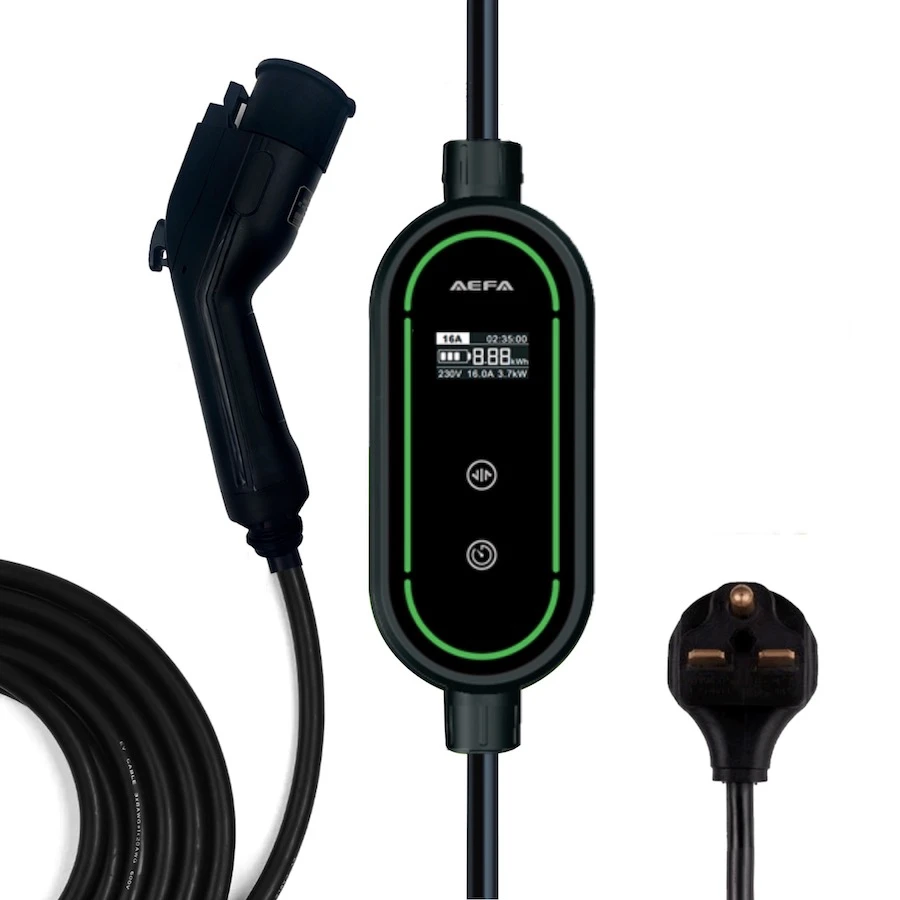
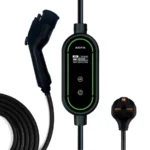
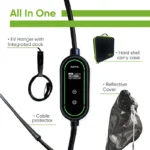
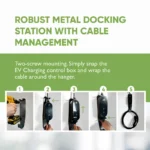
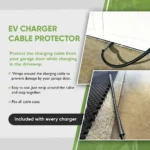
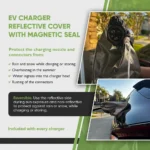
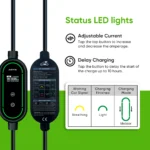
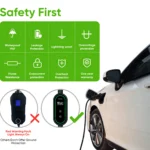
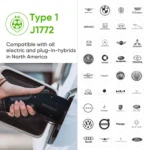
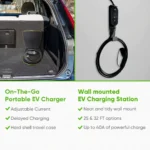
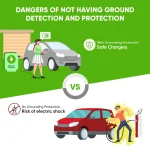
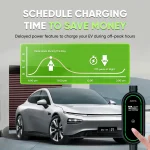
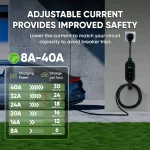
$179 – $249
Make sure the plug type you choose matches the outlet type you have at home. While many outlets look similar, they are definitely not the same. The one called NEMA 5-15 is the regular 120V household outlet that all home appliances use, while other outlet types, such as the 14-50 or 6-50 (The two most popular EV Charging Outlets), get installed specifically for appliances or EV Chargers that require 240V. That said, there are more 240V outlet types that are commonly used, such as the NEMA 14-30, 6-30, 6-20, L14-30, and more.
This product is out of stock.
Order in the next hrs mins for delivery between 00 and 00!
Level 1 everyday and anywhere EV charging
Power up or down for your situation
Allows charging on different circuit powers
Delayed charging: Charge at night during off-peak hours
Level 2, 220/240-volt charging
Fastest charging for each plug type
High power compatibility with all EVs
EV Charger
Hanger / Storage
Cable Protector
Charging Cover
Hardshell Carry Case
Extended length: No cable stretching, driveway parking
Smallest footprint EV charger
Mobile, portable, or mountable wallbox
Ultralight for portable charging
Carry in the trunk or install at home
Ready to charge. Plug-in, no programming or hardwiring
Charge Status: Oversized oval green charge light
High Def. LCD screen and LED control box lights
Touchscreen: Easy-to-read, digital indicators
Built-in, high sensitivity breaker (RCCB)
Active leak current detection and signal









| 3 Pin Plugs | NEMA 5-15 Socket (120V), NEMA 6-30, NEMA 6-20 (240V) |
| 4 pin Plugs
Rating Rated Currents |
NEMA 14-50, NEMA 6-50, NEMA 14-30, NEMA L14-40 (240V)
Indoor/Outdoor rated for installation anywhere 12, 16, 20, 24, 32 and 40 amp |
| Weight | 14 pounds |
| Connector Type | Type 1 (SAE J1772) lockable. Fits all cars including Tesla with Tesla supplied adapter |
| Control Box Dimensions | 2 inches deep x 3.5 inches wide x 8 inches long |
| Cable Length | Convenient 25 feet or 32 feet (total charging length from wall socket 26 feet and 34 feet) |
| Protection | IP67 (international standard EN 60529) |
| Assembly
Temperature |
None
22 degrees Fahrenheit to 140 degrees Fahrenheit |
| Warranty | 12 months |
| Input voltage | 208-240 Volts alternating current (AC), single phase |
| Approvals | CE, CB & TUV Approved |
| Material | Premium TPU with thin and lightweight cable |
| Compatibility | Suitable for all U.S. and Canadian EVs (SAE J1772 inlet) |
| Integrated DC Leakage Protection | Type B residual current detection |
| Surge Protection | Over/under voltage, overload protection, short circuit protection, leakage current protection, over
temperature protection, lightning protection, active ground detection |
| Ground Monitoring | Yes |
| Residual Current Detection | Alternating current 30 milliamps (mA), Direct Current 6 milliamps (mA)
*Requirements of GB 14048.2 – 2008, GB 16916.1-2014 and GB 22794-2008 |
| Features | LED indicator lights to manage charging errors |
Find clear solutions to your questions about compatibility, installation, and using EV chargers.
If you don’t find the answer you need, feel free to contact us.
Many people ask this question and the answer is yes, all EV chargers are the same. There are two different types of charger that can be used to charge an electric vehicle. They are called level 1 and level 2 chargers. Level one chargers require a regular home outlet for power while level 2 chargers use 400-480 volts which would need to come from special equipment installed at your house or business. This means you are able to charge your car much faster using a level 2 chargers.
At first, all electric vehicles were only designed to use level one chargers but now most manufacturers offer an option for installing a level two charger at home or work.
What does Level 2 EV charging mean? Level 2 chargers are also known as 240-volt fast chargers, and they can charge an electric car in about 30 minutes. They offer a substantial time-saving advantage over Level 1 or 120-volt “level one” chargers which take around 4 hours to fully recharge your vehicle’s battery. So the question is: Is it worth spending the extra money on a Level 2 charger if you have a Level 1 outlet at home?
There are a few things to consider. Level one chargers come with the purchase of many electric vehicles, so you should double-check with your manufacturer about what type of charger they provide and whether or not this is included in the price. If it’s not, there will be an additional cost for installation as well. The good news? We stock a whole range of level 2 ev chargers.
There are three different types of EV charging plugs that you can use to charge your electric vehicle. What is the difference between them? The first type of plug, called a Type 1, is used by most cars and trucks made in North America. This is also known as an SAE J1772 connector. It looks like this:
The second type of plug, known as a Type 2 or Mennekes connector, is used by many Asian brands such as Nissan Leaf and Mitsubishi Outlander PHEV.
Lastly there’s the Tesla Supercharger which allows for high-speed charging – delivering up to 120 kW from a single car charger with no reduction in battery performance or capacity over time.
Yes, all US electric and plug-in hybrid cars use a Type 1 connector. This is sometimes referred to as an SAE J1772. The Type 1 (SAE JA772) plugs support Level 1 and Level 2 charging standards. Using our EV chargers you will be able to charge all Electric cars and Plug Hybrids including Ford, Tesla, Nissan and Mercedes.
No. Cars accept any EV chargers irrespective of source. Many car manufacturers in fact recommend the use of 3rd party or the purchase of more powerful level 2 EV chargers
$179 – $249
Leave us your e-mail to notify you when it is available
"*" indicates required fields
Limited time only 11/20 – 12/03. No code needed
Limited time only 11/20 – 12/03.
No code needed